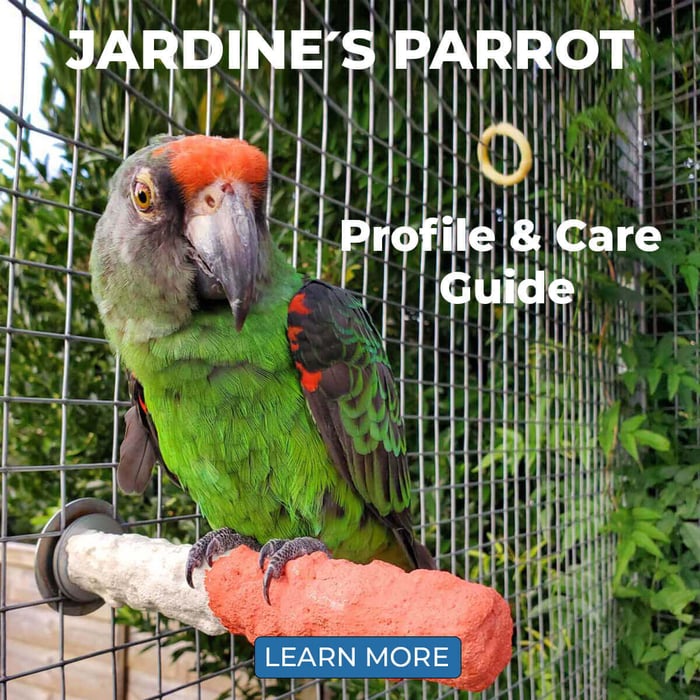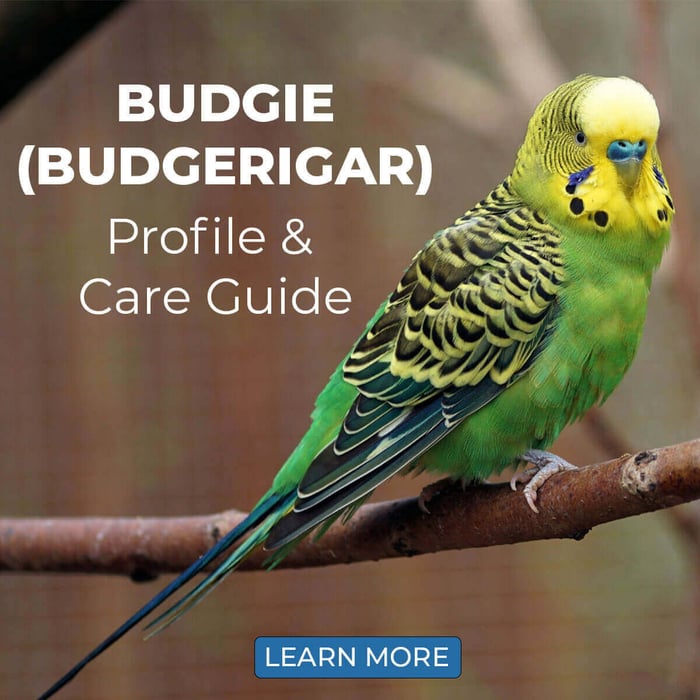Blue and Gold Macaw – Profile & Care Guide
| Common name: | Blue and gold macaw, blue and yellow macaw |
| Scientific name: | Ara ararauna |
| Length: | 84 cm/33 inches |
| Weight: | 1000-1100 grams |
| Lifespan: | Up to 60 years |
| Origin: | Brazil, Bolivia, Colombia, Ecuador, French Guiana, Guyana, Panama, Paraguay, Peru, Suriname, Venezuela |
| Noise level: | Loud! Amongst the most raucous of parrots |
NATURAL HABITAT
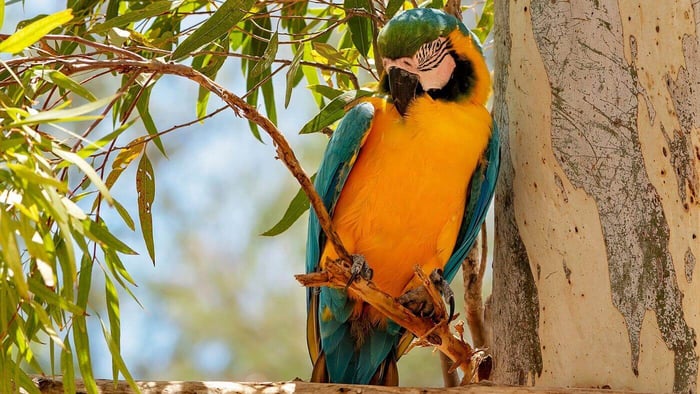
The Blue and Gold Macaw is naturally found in South America and a small part of southern Central America (Panama). It inhabits low-altitude tropical floodplain forests, woodland, tree-dotted savannahs, and palm swamps.
In the wild, these macaws mainly feed on fruits. Palm fruits are particularly favoured, although nuts, leaf buds and seeds are also eaten.
Because of its large natural range, the IUCN Red List considers Ara ararauna to be a species of Least Concern. It does note that it’s still heavily traded, which could affect the wild population. Habitat loss is also likely.
BLUE AND GOLD MACAW INTELLIGENCE & PERSONALITY
The Blue and Gold Macaw is a popular parrot species that doesn’t just stand out thanks to its beautiful colours but also its impressive intelligence and huge personality. You’ll never be bored with one of these parrots around.
B&Gs are not only smart and capable of learning numerous tricks and commands but also endlessly playful. They can make great pets for the right owner and form strong bonds with their human flock. However, it’s important to know that parrots, especially the large species, are very high-maintenance.
Macaws’ huge intelligence comes with a strong need for constant mental stimulation. Blue and Gold Macaws are known for their chewing habit, for example. This is a natural behaviour that keeps their beaks healthy and provides enrichment, but it can lead to furniture being destroyed if not properly managed. It’s essential to provide your bird with a variety of toys and activities to satisfy its urge for destruction.
If you’d like to own a Macaw, it’s important to be aware of their powerful beaks. These parrots don’t normally use their beaks to inflict pain, but they can lash out when scared or provoked. Their bites can cause serious injury! Early socialization and proper training are highly important for these large birds.
TALKING ABILITY
The Blue and Gold Macaw is renowned for its impressive talking ability. These parrots are mimic masters! Although whether a parrot learns to talk or not always depends on the individual, Blue and Golds will usually quickly remember and imitate a variety of household sounds, tunes, and words. Their voices are quite clear.
With great talking ability comes a considerable noise level. If you have a Blue and Gold in your home, it’s going to make absolutely sure you never forget about its presence. These are naturally vocal birds with loud calls. After all, in the wild, they need to be able to hear their flock members even if they’re sitting a few trees over.
In a home setting, their vocal nature means these macaws are not a good fit for you if you can’t stand a lot of noise. They’re also not really suitable as apartment birds. Their screams easily traverse walls, floors, and ceilings!
FEEDING & SUPPLEMENTS
These macaws aren’t known for fussy eaters but remember that a balanced diet is crucial for their health and well-being. They require a little more fat in their daily diet than most other parrots. You can feed your bird high-quality formulated pellets for large parrots as a staple. Supplement with a variety of fresh vegetables and fruits daily.
In addition to the basics, you can enrich your Blue and Gold Macaw’s diet with high-quality mixed seeds, soaked and sprouted pulses, and whole grains. Occasional nuts, like Brazil nuts, are excellent for providing the necessary fats. Lastly, it’s beneficial to include some extra protein in your bird’s diet. You can do this by offering small portions of white meats like lean chicken or maybe some boiled egg.
Make sure your bird has access to fresh, clean water at all times. Both food and water dishes need daily washing to maintain hygiene and prevent any health issues related to spoiled food or contaminated water.
HOUSING FOR YOUR BLUE AND GOLD MACAW
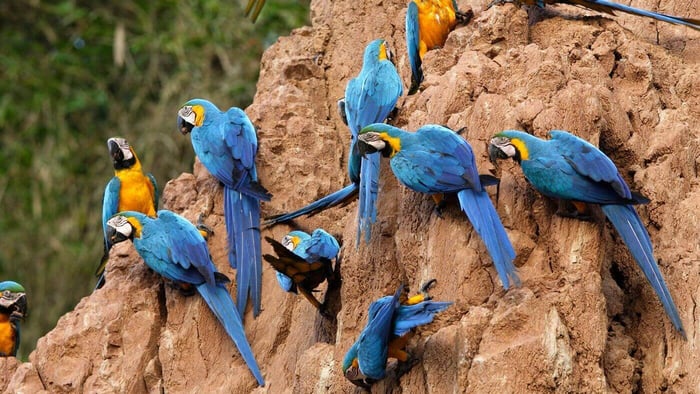
When it comes to housing a Blue and Gold Macaw, space is obviously the priority. These are among the largest parrots in the world! The cage should be as large as possible to ensure ample room for your bird to move, play, and stretch its wings.
As a basic guideline, the minimum cage size should be at least 68 inches in height, 36 inches in width, and 28 inches in depth. This size allows enough space for your parrot to feel comfortable and be able to move around. Bigger is always better when it comes to parrot cages.
The placement of the cage is just as important as its size. It should be located in an area of your home where there’s frequent human activity but away from areas prone to harmful fumes (kitchen, garage) or drafts and excessive sun (hallways, in front of windows). Macaws are social creatures, so placing the cage in a high-traffic area of your house ensures your parrot feels involved. This reduces the risk of boredom and related behavioural issues like excessive vocalisation.
To cater to its natural chewing instincts and playful nature, it’s essential to equip your bird’s space with a variety of strong, durable toys for large parrots. As we’ve discussed, Blue and Gold Macaws are known for their powerful beaks and love for chewing things, so providing toys that can withstand their beak strength is a must. Rotate toys regularly to keep them fresh and exciting.
Last but certainly not least, remember that parrots can’t live their lives locked up in a cage. You should allow your Blue and Gold Macaw a minimum of 3 to 4 hours of out-of-cage time each day, preferably longer.
This freedom is crucial to keep your bird active, exploring, and flying, which helps prevent obesity. It also helps ensure its emotional well-being, offering it the opportunity to explore, interact with its human family, and see the world from a different point of view.
FEATHER PLUCKING
Feather plucking is often seen amongst this parrot species, but it is not as common as it is in African Grey Parrots and Cockatoos; it still happens. They require loads of mental stimulation and can turn to auto-mutilation if they feel stressed, bored, lonely, or physically uncomfortable.
BLUE AND GOLD MACAW FACTS
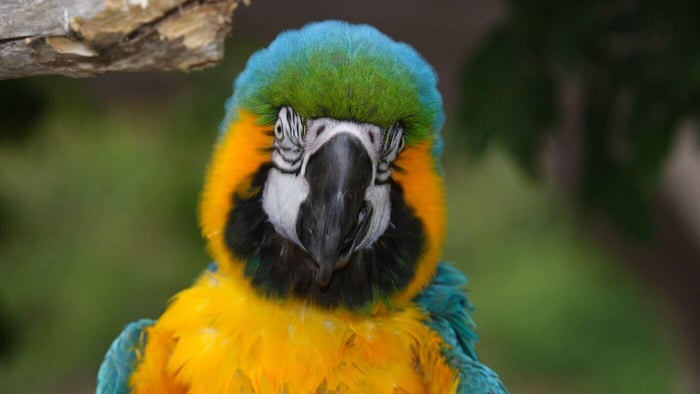
- Like other parrots, Blue and Gold Macaws are highly social. In the wild, they live in pairs or small flocks up to around 25 birds.
- Some South American parrots, including these, have a strange tendency to eat dirt. They visit clay licks to consume the soil, which helps them obtain important minerals that they can’t get from their regular diet.
- This species prefers nesting in palm tree tops, particularly dead ones.
- There are currently eight species in the genus Ara. Some of them, like the Green-Winged Macaw, are also popular as pets.
- The Blue and Gold Macaw is an introduced species in a few places where it doesn’t naturally occur. There’s a population in Florida and another in Puerto Rico.
CONCLUSION
In summary, their sociability and even temperaments can make the Blue and Gold Macaw a great pet. However, this is a parrot species for experienced bird people only. They are only suitable for dedicated, responsible, and well-informed owners.
To view other Parrot Profiles & Care Guides, visit our Alphabetical list of Parrot Fact Sheets by visiting: https://parrotessentials.co.uk/blog/parrot-profiles-care-guides
Sources
Parr, M., & Juniper, T. (2010). Parrots: a guide to parrots of the world. Bloomsbury Publishing.


